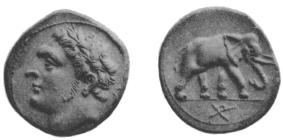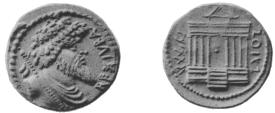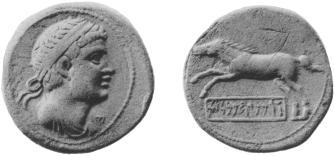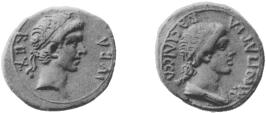
FIG. 396.



[L. Müller, Numismatique de l'ancienne Afrique, 1862. vol. iii, pp. 1-77 and Supp., pp. 60 f.;
Babelon, Rev. Num. 1889, pp. 393 f.; Cagnat, op. cit.]
Although the attempt of Zobel de Zangroniz to disprove the African origin of the regal coins of Numidia has failed (see Babelon, loc. cit.), much uncertainty still attaches to their distribution among the various kings :—Masinissa (B.C. 202-148); his sons Micipsa (148-118), Gulussa (148-140?), and Mastanabal (148-140?); his grandsons Adherbal (118-112). Hiempsal I (118-116), and Jugurtha (118-106); and his great-grandson Hiempsal II (106-60).
Masinissa (B.C. 202-148). Uninscribed AR Phoenician didrachms (116 grs.) with obv. Beardless male head, rev. Horse and palm-tree (attribution doubtful). Æ (size 1.3) with obv. Bearded laureate head, rev. מסנסן הממלכת (Masinisan hammamleket, Masinissa the king), Horse and caduceus. Babelon, p. 399, no. 1. Also Æ (size 1.05); obv. Similar head, rev. Similar inscr., Elephant (Babelon, Mélanges Num., i, pp. 320 f.).
Masinissa or Micipsa. Æ or lead; obv. Bearded head, laureate or diademed, rev. Free horse (sometimes with palm-branch); inscr., מן or מן הת (abbreviation of Mastiniçan or Mikipzan hammamleket). Babelon, p. 399, Nos. 2, 3.
Micipsa (B.C. 148-118) and his brothers.
| Bust of Victory. [Müller, p. 16, Nos. 6, 7.] |
Free horse. AV Stater 116 grs.
|
| Beardless male bust. [Brit. Mus. Guide, Pl. LIX. 30.] |
Horse and palm-tree AR Didr. 116 grs.
|
| Similar. [Müller, p. 17, No. 12.] | Horse; above, disk and uraei AR Didr.
|
| Similar. [Müller, p. 17, Nos. 13-15.] | Horse. AR Drachm and ½ drachm.
|
| Head of Melkart, bearded, laur., with club at shoulder. | Elephant with rider [Müller, p. 17,
No. 16]. AR Tetradr. 225.3 grs.
|
| Similar, hut beardless. [Müller, p. 17, Nos. 17, 18.] |
Elephant. AR Tridr. and ½ dr.
|
Gulussa (B.C. 148-140?). Æ or lead; obv. Bearded head laureate, rev. Free horse גן (= G[ulussa]n). Babelon, p. 399, No. 4.
Adherbal (B.C. 118-112). Æ or lead; obv. Bearded head laureate, rev. Free horse אל (A[dherba]l). Babelon, p. 399, No. 5.
| Head of king with wreath and diadem entwined. | Elephant א (Fig. 396) AR Didr. 119 grs.
AR Dr. 53 grs. AR ½ dr. 24 grs. |

Hiempsal II (B.C. 106-60). AR denarii, quinarii, sestertii; obv. Male head crowned with corn, rev. Free horse (sometimes in wreath); ח or חת (= H[iempsal hammamleke]t) (Müller, p. 38, Nos. 15-47). Also AE; obv. Head of Demeter veiled, rev. Free horse with palm-branch or wreath, ח (Müller, Nos. 48, 49).
Mastanesosus, Numidian dynast, circ. B.C. 62 (Cic. in Vat. v. 12; see Z. f. N., iii, pp. 40 f.). Æ of barbarous style; inscr. משתנצן (Masta- nazan), sometimes also ממלכת (mamleket, king); types—Long-haired beardless head; Female head, veiled and diademed; Ear of corn and bunch of grapes, in wreath (Müller, iii. p. 48, Nos. 59-61).
Juba I, B.C. 60-46. The coinage of this king consists of denarii and quinarii of the Roman standard and of bronze coins (Müller, iii, p. 42).

| REX IVBA Bust of Juba bearded, with hair elaborately arranged in formal curls, and with sceptre at his shoulder. | יובעי הממלכת (Yub'ai hammamleket, Juba
rex) in Neo-Punic characters. Type,
Temple (Fig. 397). AR 66-45 grs.
|
| REX IVBA Bust of Victory. | Same inscr. Galloping horse AR 30 grs.
|
| Bust of Juba. | Galloping horse. AR 28 grs.
|
| Head of Numidia in elephant-skin. | Lion. AR 13 grs.
|
The bronze coins bear the same Neo-Punic inscription, but are without the Latin one; obv. Head of Ammon or of Numidia in elephant-skin, rev. Elephant, Temple, Palace, or Lion.
The coins are chiefly remarkable for the characteristic portrait of the king, whom Cicero (De Lege agra. ii. 22) calls ‘adolescens bene capil- latus’. Cf. also Suetonius (J. Caesar, c. 71), who relates how Caesar on one occasion pulled Juba by the beard.
After the victory of Caesar at Thapsus, B.C. 46, and the death of Juba, Numidia was divided between Rome and her African allies. It is probable that some of the towns continued to strike bronze money down to the time of Augustus.
Cirta (Constantine), the capital of Numidia, and the chief royal residence. Bronze with Punic legends, perhaps representing the names of other cities, בדמלקרת כרטן (Bdmlkrt Krtn) or אלבת (‘lbt, Müller, iii, p. 60).
| Turreted female head. | Horse. Æ 1.0
|
| Id. | Two upright ears of corn. Æ .7
|
In B.C. 46 P. Sittius received Cirta from Caesar; it became a colony under the name Colonia Iuvenalis Honoris et Virtutis Cirta. It issued Æ with types. Heads of VIRTVS and HONOR, of P. SITTIVS, of Jupiter, and names of the quattuorviri, Mugonianus, &c. (Babelon, Rev. Num., 1889, pp. 502 f.).
Gadiauphala (Ksar Sbai), some thirty-five miles south-east of Cirta. Müller (iii. 65) attributes to this town bronze coins resembling those of Cirta, but reading עא (‘Aa).
Hippo Regius (near Bona) and Tipasa (Tifesh). Hippo Regius was a maritime city near the mouth of the river Ubus. Tipasa was about forty- four miles south of Hippo, and connected with it by a road. The two places appear to have struck money in common (Müller, iii, p. 53). Inscr., אפון (‘pon) and טפעתן = (Thp'tn). Types—Head of Baal laur. and surmounted by star, behind, sceptre, rev. Head of Astarte veiled and surmounted by disk in crescent; Head of Melkart surmounted by star and with club behind, rev. Head of Egyptianized divinity, wearing bonnet, surmounted by star and with axe behind; Youthful head, rev. Panther leaping to right.
Macomades (Kur-el-Ahmar), an inland town of Phoenician origin, about forty miles south-east of Cirta. Bronze of late autonomous times. Inscr., מקמא (= Mqma). Types—Head of Egyptianized divinity, in close-fitting cap with two floating ribands at the top, rev. Hog; Horse galloping, rev. Disk in crescent.
Salviana (?). Bronze of autonomous times. Inscr., אשלבן (= Aslbn). Type—Veiled bust of Phoenician goddess with caduceus, rev. Horse, above, crescent and disk (Müller, iii, p. 68).
Suthul, between Cirta and Hippo Regius. Bronze of late autonomous time. Inscr., סת (= St). Types—Head of Sarapis wearing modius, or of Hermes in petasos, rev. Wreath (Müller, iii, p. 59).
Thabraca (Tabarka) and Tuniza (La Calle), two maritime towns to
the east of Hippo Regius. Late autonomous bronze in alliance. Inscr.,
תברכען (= Tbrk'n), and תננען (= Tnnṣn). Type—Veiled head of
Astarte, rev. Beardless head with ringlets; behind, ![]() , symbol of Baal
(Müller, iii, p. 52).
, symbol of Baal
(Müller, iii, p. 52).
Tipasa. See Hippo Regius.
Tucca (?). Late autonomous bronze. Inscr., אתג (‘tg). Heads of the Dioskuri or Kabiri laur., each surmounted by star, rev. Horses of the Dioskuri. These coins have also been attributed to Utica (Müller, ii. 164).
Zarai (Zraya), in the south-west of Numidia. Bronze of autonomous
times. Inscr., סראע (= Sra'a). Type—Head of Astarte (?) crowned
with myrtle, rev. Cornucopiae in myrtle-wreath.
[Müller, Numismatique de l'ancienne Afrique, iii, pp. 78 f. and Suppl., pp. 69 f.;
Babelon, Rev. Num., 1889, pp. 403 f.; Cagnat, op. cit.]
Syphax (circ. B.C. 213-202). Æ. Inscr. ספק הממלכת (Spq ham- mamlekent). Types—Diademed head of king, or Bare male head, rev. Horseman galloping (Müller, iii, p. 90, 2-4, iv, p. 69).
Vermina, son of Syphax (circ. B.C. 200) (Müller, iii. p. 88, iv, p. 69; Babelon, p. 403).
| Bust of king, diademed (Fig. 398). | ורמנד הממלכת (Urmnd hammamleket)
Horse galloping. AR 227.6 grs.
|

Bocchus I or II, or Bogud I (first half of first century B.C.).
| Head of king, diademed. [Müller, iv, Pl. III. 4 a.] |
Prow of war-vessel. AR 228.4 grs.
|
| Id. [Müller, iv, Pl. III. 4 b.] | Id. AR 109.2 grs.
|
Bogud II (circ. B.C. 49-31), king of western Mauretania (Müller, iii, p. 95).
| Griffin devouring stag. [B. M. Guide, Pl. LXX. 40.] |
REX BOCVT Griffin standing, above
which, winged disk.
AR Denarius 64 grs.
|
| Head of Africa in elephant-skin. | Id. AR Denarius 45 grs.
|
| Bearded head. | REX BOCVT Prow. Æ .95
|
Bocchus II (III), king of eastern Mauretania, circ. B.C. 49-38, and of eastern and western Mauretania B.C. 38-33. Bronze. Inscr., בקש (Bqs) or פקש (Pqs), rev. שיגען (= Sigan), indicating that they were struck at the town of Siga. Also בקש הממלכת and שמש = ‘Bocchus the king’, struck at Semes. Types—Male head with pointed beard, rev. Bacchus (?) holding a small bull by one horn; Star, grapes, and ear of corn (Müller, iii, p. 98, iv, p. 72).
There are also Æ coins with inscr. בקש הממלכת (or פקש), REX BOCCHVS, and SOSI F?; types, Bust of Africa in elephant-skin, rev. Head of Janus, or Male head, rev. Elephant. These Müller (iv, p. 73) attributes to the Interregnum of B.C. 33-25.
Juba II, B.C. 25-A. D. 23. This king was the son of Juba I, who lost his kingdom at the battle of Thapsus. He was made king of Mauretania by Augustus, and married first Cleopatra Selene, daughter of M. Anto- nius and the famous Cleopatra, and afterwards Glaphyra, daughter of Archelaus of Cappadocia, on whose coins some of his own are modelled. His silver coins, denarii of light weight, are very plentiful (see Dieu- donné, Mél. Num., i, pp. 320 ff). They read REX IVBA, and in the latter part of his reign the regnal year is added on the reverse (e.g. R. XXXI, &c.). They bear as a rule the head of Juba on the obverse and various types on the reverse : Head of Africa; Elephant; Lion; Eagle holding hare; Head of Herakles; Club, and other symbols of Herakles; Horse- man spearing boar; Cornucopiae; Star and Crescent; Altar, on which Uraeus; Altar between trees (LVCV[s] AVGVSTI); Capricorn; Temple of Augustus; Nike, &c.; and sometimes a wreath, within which is the name of the capital of Mauretania, Caesarea, the ancient Iol. The bronze coins are less numerous. On some of these the inscription is in Greek ΒΑCΙΛΕWC ΙΟΒΑ (Müller, p. 107).
The city of Carthago Nova conferred upon Juba the honorary title of Duumvir quinquennalis. Cf. Müller, iii, p. 111.
Juba II and Cleopatra, or Cleopatra alone. Denarii and bronze; inscr., REX IVBA (sometimes also REGIS IVBAI F) on the obverse, and

ΒΑCΙΛΙCCΑ ΚΛΕΟΠΑΤΡΑ on the reverse; types, portraits of Juba and Cleopatra (Fig. 399), or types referring to the worship of Isis, and other Egyptian divinities. Others bear the head and name, always in Greek, of Cleopatra alone.
| REX PTOLEMAEVS Diademed head. [Mommsen, Sitzungsber. Berl. Akad., 1883, xliii.] | R A XVIII Wreath on sella curulis, with
sceptre leaning against it.
AV 48.8 grs.
|
| Id. [British Museum.] | PIETATI R A XV (?) Altar. AV 48 grs.
|
The denarii of this king are all of very light weight and inferior in execution to those of his father. Inscr., REX PTOLEMAEVS, and date R(egni) A(nno) I, II, &c. Types—Palm-tree, Elephant, Cornucopiae, Club, &c., &c.
The bronze coins read REX PTOLEMAEVS REGIS IVBAE F. or REG(nante) REGE PTOLEMAEO.
The inscr. REX PTOL in the centre of certain bronze coins of Car- thago Nova proves that that city paid the king of Mauretania the com- pliment of electing him as one of the municipal Duumviri quinquennales. Ptolemaeus was invited to Rome by Caligula A. D. 40, and there assas- sinated, after which Mauretania was constituted a Roman province.
Babba, a Roman colony founded by Augustus, under the title Colonia Campestris Julia Babba, abbreviated on coins C. C. I. B. Other inscrip- tions are D. D. PVBL. (Decreto Decurionum publico), and EX CONSENSV D(ecurionum). Bronze of Augustus (Rev. Num., 1889, p. 506), Claudius, Nero, and Galba. Types—Bull swimming; Bridge of three arches, &c.
Camarata, a maritime town not far from Siga. Bronze of barbarous work. Inscr., כמא (Km'a), obv. Rude head, rev. Grapes and ear of corn (Müller, iii, p. 143).
Iol, a town of Phoenician origin, was the residence of Juba II, by whom its name was changed to Caesarea. The inscr. CAESAREA occurs on denarii and bronze of Juba II, and on autonomous bronze of about the same time (Müller, iii, p. 138).
Lix, the most important town on the western or Atlantic coast of Mauretania. The coins are of the late autonomous period, with the Neo-Punic inscr. לכש and מבעל לכש (= Lks and Mbal Lks, the people of Lix), also LIXS and LIX. Types—Head of divinity in conical hat with cord hanging from the top, rev. Two bunches of grapes; Two fishes; Altar, &c. (Müller, iii, p. 155).
Rusadir (Müller, iv, p. 78). Late autonomous bronze Inscr., רשאדר (Rs'dr), Bearded head, rev. Bee between ears of corn.
Sala, on the Atlantic coast, bordering upon the desert. Late autono- mous bronze coins with Neo-Punic inscr. שעלת (S'lt), Bearded head, rev. Grapes with ear of corn and disk within crescent (Müller, iii, p. 163).
Siga, on the Mediterranean coast, near the mouth of a little river of the same name, between Caesarea and Tingis. Regal bronze of Boc- chus II (III), q. v.
Tamusida or Tamusia, on the Atlantic coast, about thirty miles north of Sala, probably identical with the Thymiateria of Scylax. Late auto- nomous bronze with Neo-Punic inscr. תמדעת (Tmd't ?), Head of bearded divinity, rev. Two ears of corn (Müller, iii, p. 162).
Timici, an inland town in the western part of Mauretania Caesari- ensis. Late autonomous bronze. Inscr., תמכי (Tmki), Bearded head, rev. Grapes between two laurel branches (Müller, iii, p. 143).
Tingis, now Tangiers, on the straits of Gibraltar, the chief town of Mauretania Tingitana. Late autonomous bronze with Neo-Punic legends, בעלת תתגא (B'lt Ttg') בעלת תינגא (B'lt Ting'), or מבעל תינגא (Mb'l Ting'), &c. (city or citizens of Tingis) (Müller, iii, p. 144), Bearded head of Baal without neck, or of Demeter, &c., rev. Ears (or ear) of corn. Also Imperial—Augustus and Agrippa, with Neo-Punic and Latin legend, IVL TIN, rev. Bearded head of Baal facing.
Zilis, about twenty miles south of Tingis. Late autonomous bronze, with Neo-Punic inscr., אשלית (‘slit), Head of Hermes with caduceus, rev. Two upright ears of corn (Müller, iii, p. 153).